Kubota Garden

|
||
| Licensing | ||
Kubota Garden is a public garden that is now owned by the City of Seattle and maintained by the Department of Parks & Recreation. In 1981, it was designated an Historical Landmark of the City of Seattle. The garden is free to the public and open during daylight hours. The garden was originally created and maintained for many years by Fujitaro Kubota, an Issei was born in Kochi Prefecture, Shikoku in 1879. He came to the United States in 1907. He was entirely self-taught as a gardener. He established the Kubota Gardening Company in 1923. In 1927, he began his garden. It was used as a design and display center for his business, as well as a nursery to grow plant materials for gardens installed by the company. They also shared access to the garden to the local Nikkei community for social and cultural activities. During WWII, the garden was abandoned while the Kubota family were incarcerated at Minidoka concentration camp in Idaho. Fujitaro and his sons, Tak and Tom, rebuilt the landscape business after their return. In 1972, the Japanese Government awarded Fujitaro Kubota with the Fifth Class Order of the Sacred Treasure, "for his achievements in his adopted country, for introducing and building respect for Japanese Gardening in this area." Fujitaro passed away the following year at the age of 94. On a trip to Seattle, Washington in early July, 2007, we went to Kubota Garden. It was a bright and sunny day, but thankfully not too hot. Here are photos from our visit. Hope you enjoy! Kubota Garden 9817 55th Avenue S. Seattle, Washington 98118 Information above is from the Kubota Garden website: kubotagarden.org. The site includes a brief history, photos, schedule of events, wedding & tour information, membership info, event info, map, and directions.
Slides in this album |
|

|
Signage from the roadKubota Garden is in a residential area in southern Seattle. Apparently, it's a little difficult to find if you're not familiar with the area. Luckily, it's very close by to where my relatives live, so we walked. This stone sits at the corner of the side street where you turn … |

|
Entry gateThe entry gate is a beautiful, bronze sliding gate designed and installed in 2004 by Gerard Tsutakawa, the son of renowned Pacific Northwest sculptor George Tsutakawa. View the original item to see more information about the artist and the gate. |
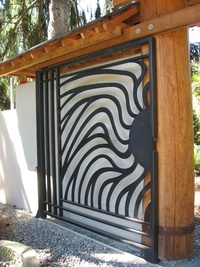
|
Left door of entry gateThe gate was open, so this is only the left half. It looks like an abstracted sun/wave motif. |
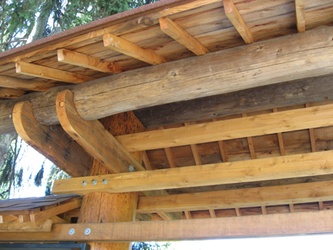
|
Top of the gateThis is the top center portion as you walk through the gate. |
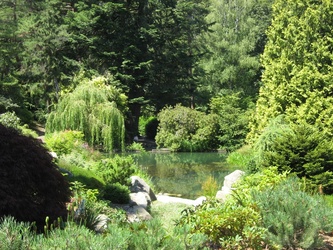
|
Spring PondThis is the Spring Pond. According to the brochure I picked up at the entrance, the Spring Pond is "fed by several local springs. The Kubota family used it to water six acres of nursery stock once planted to the south." |
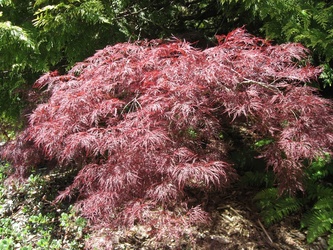
|
Pretty treeThis was from the Nursery Plantings section. The brochure describes this section as being "of bamboo, yew, birch, and other plants remain from the nursery days." I don't know what kind of tree this is, but it stood out because of its color and its light, feathery leaves. Sadly, the … |
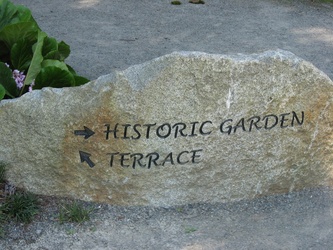
|
Directional signageThere were several signs like this one engraved into stone to help you find your way. Even with the map, it was a little confusing finding our way around and back. The garden is sprawled over 4.5 acres of land and features many twisting walkways that guide you through. The … |
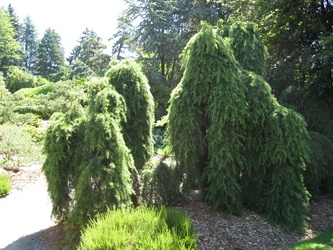
|
Animal trees =)This was also from the Nursery Plantings section. I don't know what kind of trees they are, but there were quite a few of these types in the garden. If you know what these are, please add a comment and let me know! The trees looked very soft and seemed … |
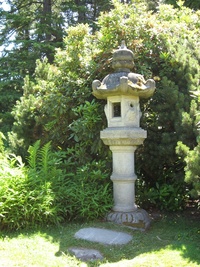
|
Stone lanternI believe this was at the Japanese Garden part of Kubota Garden which is the oldest part, completed in the 1930s. It's also the most traditional part of the garden. |
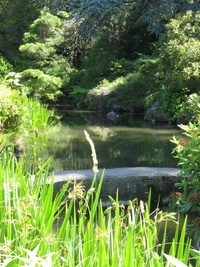
|
Japanese Garden spring pondThis bridge is above the pond in the Japanese Garden section. According to the brochure, the Japanese Garden "features a spring-fed pond and stones left in the Seattle area 12,000 years ago by the last glacier."
Kubota Garden pond & stone bridge in Japanese Garden |
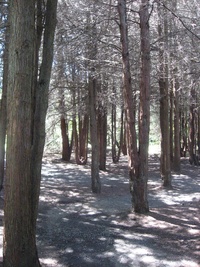
|
Fera Fera ForestAccording to the brochure, the Fera Fera forest is "a tranquil refuge, originally a nursery planting of Threadleaf Cypress." I was curious where they got the name Fera Fera Forest. Google and Yahoo! searches for 'fera fera' didn't result in anything relevant. Then, I tried a search on 'threadleaf cypress' … |

|
Pine treesThis is one of the many pine (matsu) trees in the garden. It's in the Tom Kubota Stroll Garden. According to the brochure, the stroll garden "features long views, many places to sit, and stone from the high Cascades. It was designed and built in 1999 by Tom Kubota, … |
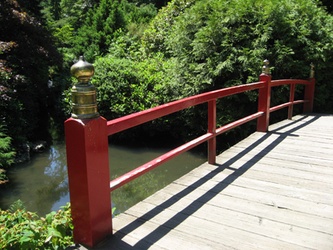
|
Heart BridgeThis is the Heart Bridge. It's one of two red bridges in the garden. Like the Japanese Garden, this was also built in the 1930s. The brochure says that the Heart Bridge "crosses Mapes Creek and is like a traditional red bridge on Mr. Kubota's home island." Mapes Creek is … |

|
Stone bridge over Mapes CreekActually, this is only half of the bridge that crosses Mapes Creek near the Heart Bridge. I took this photo standing on Heart Bridge. The stone bridge is fairly narrow, but you can still traverse carefully across (or dash across for the daring!). |
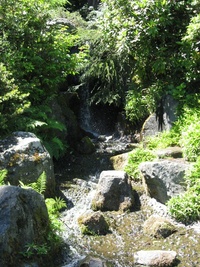
|
WaterfallThe waterfall is part of the Mountainside section. It was built by the Kubota family to celebrate the 1962 World's Fair in Seattle, and offers the visitor a miniature walk into the mountains. The waterfalls are formed by stone from North Bend and fed by water pumped up from the … |
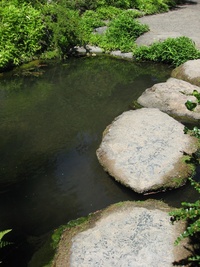
|
Stepping stonesThese stones provide a pathway across the waterway at the bottom of the main waterfall area. I took the waterfall picture in the previous photo standing on one of these stepping stones. |

|
Stone stairsWithin the garden, there are few paved roads. It is all very natural, particularly the older sections of the garden that Fujitaro built. These steps are an example of the natural elements that were used to get around the garden. |

|
LookoutWhen you get to the top of the Mountainside, just above the waterfall, there is this nice viewing/resting area. The tree branch-covered wooden umbrella offers a refreshing shade from the sun (or, I suppose from the elements if it's raining or snowing). Wooden benches provide a nice respite after … |

|
Moon BridgeThis is the other red bridge. It was built in the 1970s and features a very steep ascent and descent, which according to the brochure, symbolizes the difficulty of living a good life: "Hard to walk up and hard to walk down." |

|
Kubota TerraceThis is the Kubota Terrace. The brochure describes the terrace as having "open lawns and late summer blooming plants which welcome weddings and other gatherings." As you can guess from their text, you're able to host weddings and other events here. This photo shows a part of the expansive green … |
 vkm
vkm
 Oshogatsu 2021
Oshogatsu 2021 My Collection of Daruma
My Collection of Daruma Seattle Japanese Garden
Seattle Japanese Garden Mitsuwa Natsu Matsuri 2007
Mitsuwa Natsu Matsuri 2007 Kubota Garden
Kubota Garden Exploring My Family "Garden"
Exploring My Family "Garden" My early J-Town memories
My early J-Town memories My Hinamatsuri
My Hinamatsuri My Oshogatsu 2007
My Oshogatsu 2007 National Cherry Blossom Festival 2005
National Cherry Blossom Festival 2005
 Journal feed
Journal feed
